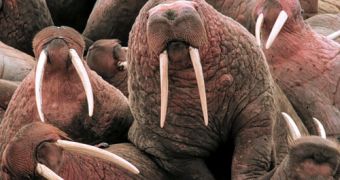No ice, no polar bears. We already know this. But what will happen with another icon of the Arctic, the walrus?
Walruses have already started to change their habits and behavior. Thousands of them have gathered on Alaska's northwest coast, as a severe effect of the Arctic sea ice melting. Usually, the breeding females are encountered in summer and fall on the Arctic ice pack. But the smallest summer ice cap on record moved the extent of sea ice far north of the continental shelf, the shallow, life-rich seabed bordering the mainland shores, where walruses search for their food: clams, snails, crabs and other bottom animals.
As the ice platform retreated beyond the continental shelf, walruses had to choose the Alaska's rocky beaches, as they cannot dive below 630-foot (210 m) when foraging.
"It looks to me like animals are shifting their distribution to find prey. The big question is whether they will be able to find sufficient prey in areas where they are looking," said Tim Ragen, executive director of the federal Marine Mammal Commission. "According to the National Snow and Ice Data Center at the University of Colorado at Boulder, September sea ice was 39 percent below the long-term average from 1979 to 2000. Sea ice cover is in a downward spiral and may have passed the point of no return, with a possible ice-free Arctic Ocean by summer 2030," said senior scientist Mark Serreze.
Since July, thousands of walruses have abandoned the ice pack where they usually gathered to install in haulouts, ground gathering places between Barrow and Cape Lisburne, a remote, 300-mile (640 km) stretch of Alaskan shore.
One immediate concern of new, massive walrus groups is the peril posed by stampedes. When panicked (and anything panics them, from a low-flying airplane or a boat to an approaching polar bear), the whole herd of walruses rushes to the sea and in the throng, offspring often get crushed by adults weighing over 2,000 pounds (900 kg).
But the greatest worry is that on a longer term walruses would experience nutritional stress if concentrated on coast rather than spread over vast areas of thousands of square miles of sea ice. Seals can spend indefinite periods of time swimming, but walruses require either ice or land to recover after foraging.
"Historically, walrus have used the edge of the ice pack like a conveyor belt. As the ice edge melts and moves north in spring and summer, sea ice gives calves a platform on which to rest while females dive to feed." said Ragen.
This does not happen on the ground.
"If they've got to travel farther, it's going to cost more energy. That's less energy that's available for other functions," said Ragen.
The same phenomenon occurs on the Russian side of the Chukchi Sea.
"If lack of sea ice is at the heart of upcoming problems for walrus, there's no solution likely available other than prevention. The primary problem of maintaining ice habitat, that's something way, way, way beyond us. To reverse things will require an effort on virtually everyone's part." said Ragen.

 14 DAY TRIAL //
14 DAY TRIAL //